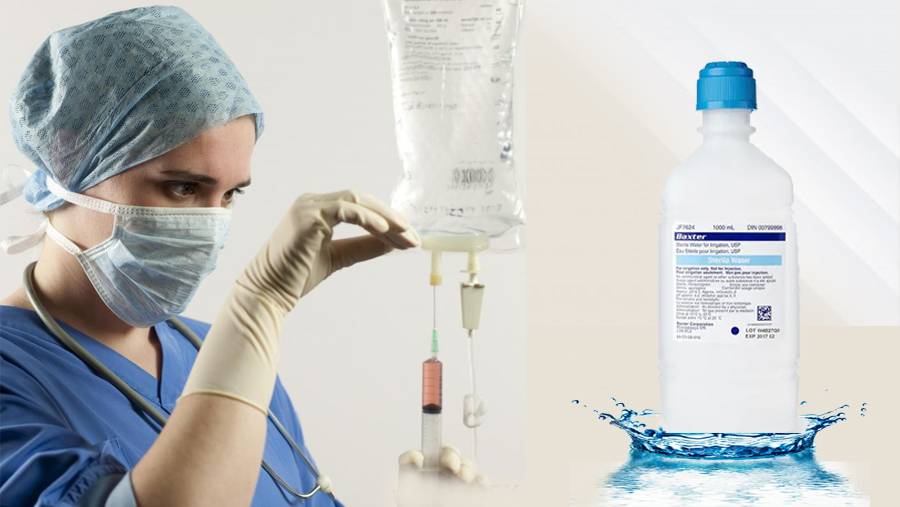
Hello
Select Address

Water is a prerequisite for life; it is used in most functional activities, from food and drink to basic medical and pharmaceutical steps and has proven to be the ultimate source of cross-contamination if not free from germs and bacteria.
What is sterile water?
Sterile water, as described by the United States Pharmacopeia, is distinguished as water that is free from viable micro-organisms. Sterilized water is devoid of any biological contamination like bacteria and viruses that can reproduce and multiply.
How is water sterilized?
Sterile water can be obtained through the following processes:
Types of Sterile Water:
There are three kinds of Sterile water recognized by the US Pharmacopeia –
Sterile Water for Irrigation
Sterile Water for irrigation is used as an irrigant (to flush out body parts). Sterile Water for irrigation is hypotonic in nature, that is, it has low osmotic pressure. It has zero osmolarity and is not used in the intravenous procedure. This kind of sterile water cannot be used for oral intake and once warmed must not be restored.
Irrigant Sterile Water is marketed in single-use containers; once the container is opened the contents must be used completely or the remnants should be discarded to avoid pathogenic bacterial regrowth because irrigant sterile water does not have antimicrobial preservatives.
Sterile Water for irrigation is only used for general irrigation – washing, rinsing and liquefying purposes. It is used as a medium for transporting medication used for irrigation purposes, for tissue and wound wash, rinsing of catheters and drainage tubes. Introduction of Irrigant Sterile Water into the blood vessels can cause haematolysis.
Sterile Water for Inhalation
Sterile water for inhalation is intended to be used as inhalators and a diluent for inhalation solutions. Even though they are rendered sterile, comparatively they have a diminished and less rigorous microbial threshold because of which they are not used for intravenous or intramuscular purposes. Continuous use of inhalators by asthmatic patients causes bronchial passage dryness and irritation. Sterile water used as inhalators serves the purpose of a humidifier.
Sterile Water for Injection
Sterile Water for Injection is a colorless and odorless liquid preparation innovated for parenteral use only when mixed with additive drugs into diluted form. It is a non-pyrogenic preparation without the presence of any bacteriostatic agent or germicides or any added catalytic agent. It is marketed in a single dosage container and is only used for the purpose of a solvent or diluent for drugs.
However, this is to keep in mind, adequate concentrations of drugs are required to be mixed to the water to make it approximately isotonic in nature and level its osmolarity. Unless isotonic, the preparation cannot be used for intravenous, intramuscular or epidermal injection. Hypertonic or hypotonic solutions used for injection can cause haematolysis.
Sterile Water Myths Busted!
1. Sterile water is safe to drink!
Several healthcare practitioners use sterile water to make nutritional solutions for both enteral as well as mouth feeding to avoid pathogenic contamination. This is unjustified because the gastrointestinal system is not a sterile environment. Each of the parts of a GI tract is saturated with symbiotic bacteria. Reduction in their number can cause multiple infections. To sum up, the administration of sterile water through food into the gastrointestinal tract is not safe.
2. Sterile Water can be given as IV!
IV literally stands for intravenous, meaning through the veins. Several cases have been reported where a physician has instructed the use of Sterile water for treating hypernatremia (an excessive amount of sodium in the body) as it is a ‘free-water’ (free from any organic and inorganic ions). Hypernatremia is caused due to the deficit of free water in the body. However, this can be balanced orally, not through IV. Sterile water is hypertonic and injecting it into the bloodline without adjusting the tonicity can cause haematolysis.
3. Sterile water does not go bad!
Sterile Water packages do not come with an expiration date printed on them, however, that does not mean they never go bad. A Sterile Water bottle is labeled as ‘single-dose container’. This label adheres to the fact that once the seal is opened the bottle must be either finished or discarded; you cannot store it.
4. Sterile Water can be bought without a prescription!
Sterile water cannot be bought over the counter without a prescription. For medical purposes, it needs to be used according to the guidelines implemented by Pharmacopeia. Reports from certain incidents showed the illegal use of Sterile Water for injection of steroids. Thus, the government of America classifies this as a prescription product.
Hope this blog provides enough knowledge about Sterile Water and its proper application in medical procedures.